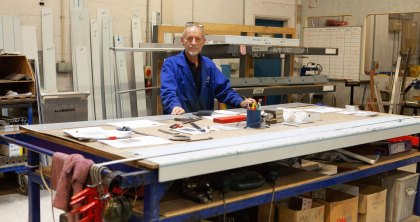Smoke and Heat Exhaust Ventilation systems (SHEV’s) are designed to assist with the natural extraction of smoke from a building during the event of a fire, and Automatic Opening Vent (AOV) roof lights can be an effective choice for this type of application.
However, specifying the correct type AOV roof light, is vital to ensure maximum safety and compliance with Building Regulations.
Although both standard and electronic opening rooflights can aid smoke clearance, they should not be used specifically for smoke ventilation purposes.
To comply with Construction Products Regulations, AOV systems must be CE marked against BS EN 12101-2:2003, a European Standard which gives the appropriate testing methods for components specifically installed as a natural smoke and heat exhaust system.
When specifying ventilation rooflights for smoke extraction purposes, ensure you choose a BS EN 12101-2:2003 compliant rooflight.
What is the purpose of smoke ventilation systems?
Smoke ventilation systems are designed to keep escape routes free from smoke and assist fire-fighting operations by creating a smoke free layer.
When using AOV’s smoke is not extracted by mechanical means; they are triggered by fire alarm systems and open to a prescribed angle so that smoke can be naturally vented to the outside.
This significantly improves the life safety protection of the building and reduces the consequential financial losses caused from smoke damage.
Where are they used?
Most smoke vent systems or AOV’s are installed in corridors or stairwells and are frequently specified in hospitals, schools, hotels or apartment blocks.
Typically, the system will consist of a base unit with a hinged lid section that is forced open by an actuator system. In terms of functionality, these systems must work flawlessly when triggered.
Common advice
The Department for Communities and Local Government Fire Statistics state that,
‘being overcome by gas, smoke or toxic fumes is partly or wholly the cause of death in over half of all fire related fatalities’.
It is therefore essential to prevent buildings from becoming smoke logged in order to allow occupants sufficient time to escape.
In a large building, common advice is to close all doors in an attempt to reduce the spread of toxic smoke. However enough air is present in corridors and stairwells to sustain a fire over a prolonged period of time; even a relatively small fire can rapidly fill a building with smoke and prevent its occupants locating escape routes through reduced visibility or smoke inhalation.
Testing to BS EN 12101-2:2003
In order to be efficient, AOV systems must undergo a series of rigorous tests which adhere to BS EN 12101-2:2003.
These tests typically include cycle testing over many thousands of operations and also testing in a high and low temperature range with no more than a 10% reduction in opening area. The unit will be required to function under snow and wind loads, whilst opening to fire position using both mains and battery power in under 60 seconds.
Any manufacturer that has carried out these tests must provide a Certificate of Conformity supplied by a UKAS accredited body. This details the loadings and temperature ranges the AOV has been subjected to during testing and should be accompanied by a Declaration of Performance.
Critical safety product
All of these tests mean that in the event of a fire the AOV system can be relied upon to perform its function and evacuate smoke from the building.
Although it may be possible to connect other types of ventilation rooflights to alarm systems to act as an AOV, this is not permitted under Construction Products Regulations.
Any system that is covered by a harmonised standard, such as BS EN 12101, has to be CE marked and therefore has to have undergone testing in accordance with the standard. Non CE marked units will not have undergone any testing and are likely to fail in the conditions they will be subjected to during a fire, potentially causing serious injury or death.
Combining performance and aesthetics
Typically smoke vent rooflights are not aesthetically pleasing. As a fire safety product, visuals are often overlooked due to the central focus placed upon functionality; actuators tend to be obstructive and create bulky framework.
Unlike many AOV roof lights, Glazing Vision’s CE marked xVent benefits from minimal framework. It is a low profile double glazed unit with a fully insulated lid section, offering superior standards of finish, improved acoustics and thermal performance. The xVent frame is engineered from extruded aluminium and the base frame is thermally broken to avoid condensation and thermal bridging. All of this is achieved using completely hidden hinged mechanisms housed within the base frame.
The Glazing Vision xVent is a fully tested and certified CE marked AOV rooflight.
Find out more about using Glazing Vision xVent for your next project.













